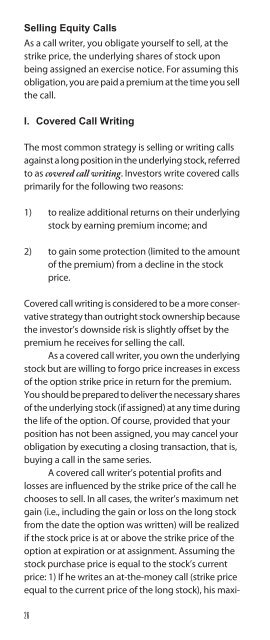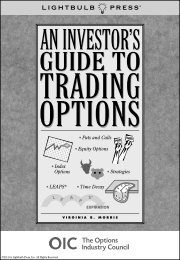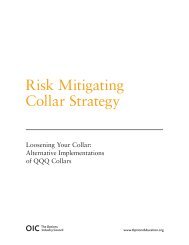Understanding Equity Options - The Options Clearing Corporation
Understanding Equity Options - The Options Clearing Corporation
Understanding Equity Options - The Options Clearing Corporation
- No tags were found...
Create successful ePaper yourself
Turn your PDF publications into a flip-book with our unique Google optimized e-Paper software.
Selling <strong>Equity</strong> CallsAs a call writer, you obligate yourself to sell, at thestrike price, the underlying shares of stock uponbeing assigned an exercise notice. For assuming thisobligation, you are paid a premium at the time you sellthe call.I. Covered Call Writing<strong>The</strong> most common strategy is selling or writing callsagainst a long position in the underlying stock, referredto as covered call writing. Investors write covered callsprimarily for the following two reasons:1) to realize additional returns on their underlyingstock by earning premium income; and2) to gain some protection (limited to the amountof the premium) from a decline in the stockprice.Covered call writing is considered to be a more conservativestrategy than outright stock ownership becausethe investor’s downside risk is slightly offset by thepremium he receives for selling the call.As a covered call writer, you own the underlyingstock but are willing to forgo price increases in excessof the option strike price in return for the premium.You should be prepared to deliver the necessary sharesof the underlying stock (if assigned) at any time duringthe life of the option. Of course, provided that yourposition has not been assigned, you may cancel yourobligation by executing a closing transaction, that is,buying a call in the same series.A covered call writer’s potential profits andlosses are influenced by the strike price of the call hechooses to sell. In all cases, the writer’s maximum netgain (i.e., including the gain or loss on the long stockfrom the date the option was written) will be realizedif the stock price is at or above the strike price of theoption at expiration or at assignment. Assuming thestock purchase price is equal to the stock’s currentprice: 1) If he writes an at-the-money call (strike priceequal to the current price of the long stock), his maxi-26










